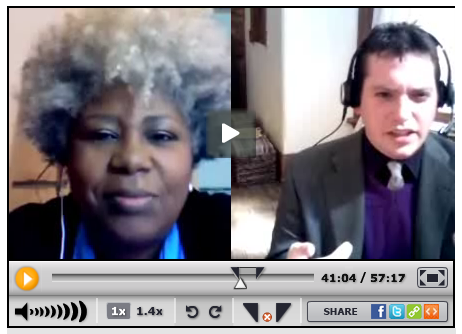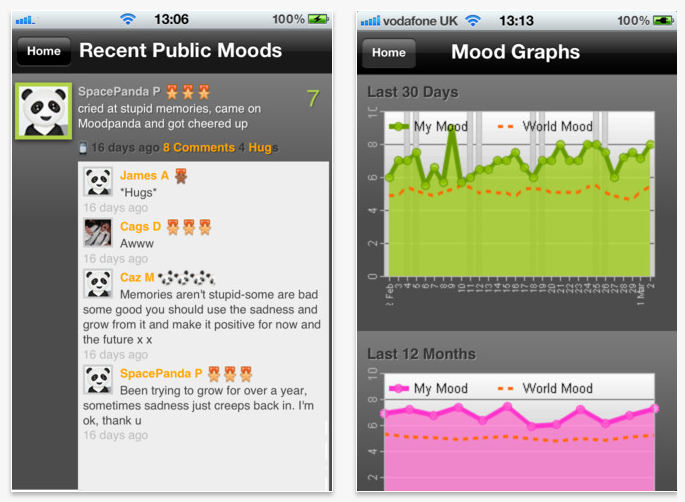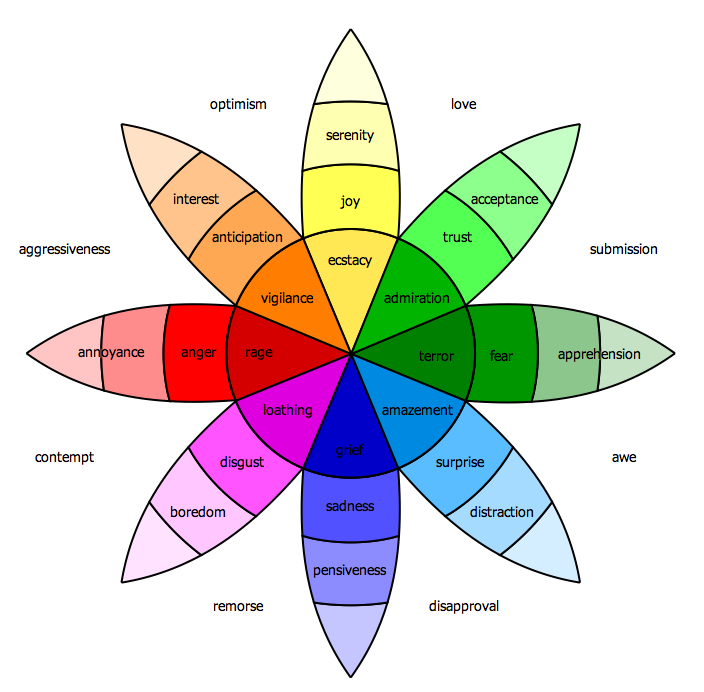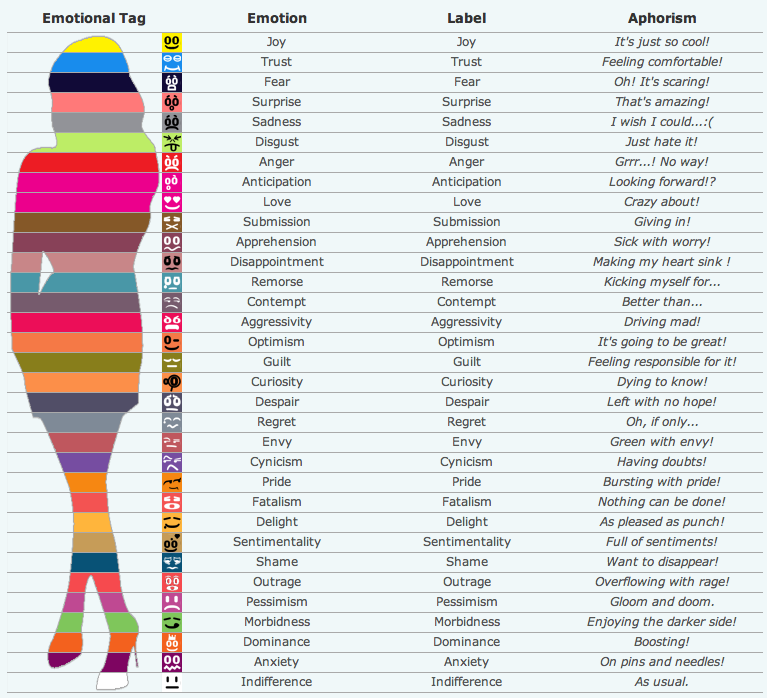Mood Sharing and Experimentation (Get Your Mood On: Part 5)
Alexandra Carmichael
February 3, 2013
Welcome to part 5 of the QS book on mood tracking that Robin Barooah and I wrote. This chapter has some tips that we’ve found helpful for getting started with mood tracking. Enjoy!
—
Once you’ve been tracking mood for a while, and have a good baseline established, it’s time to play. What if you could influence the factors that shape your mood? What if you had a trusted buddy to confide in, to make your tracking more robust? If we know ourselves better, we can make choices that help us to make the most of our lives. We’ll explore how and why to experiment with and share your mood in this chapter.
There’s a concept called heutagogy that applies nicely to self-tracking activities. Heutagogy is basically the idea that people direct their own learning, using personal experiences to update their models of themselves and the world around them. Stewart Hase and Chris Kenyon, who came up the term, write that “people only change in response to a very clear need… involving confusion, dissonance, fear, or intense desire.”
At Quantified Self, we usually see intense desire as a motivator, but fear creeps in too, often for health concerns. If you do want to change your mood, it’s helpful to know how others with similar motivations have gone about doing it, to get some ideas and approaches to adapt to your needs.
Mood Experiments
Take Seth Roberts. He is an avid self-experimenter who has discovered many ways to help with his sleep, mood, health, and weight. While he was experimenting with how to have a deeper night’s sleep, he came across an idea to watch faces on TV when he woke up. The hypothesis was that simulating human contact even though he lived and worked alone would somehow impact his circadian rhythm.
To his surprise, watching faces in the morning had the effect of making him “cheerful, calm, and full of energy” the next morning, and he felt great all day! He repeated the experiment to make sure it was the faces that were improving his mood, recording his mood on three 100-point scales: unhappy/happy, irritable/serene, and reluctant/eager. Seth played around with the amount of time he needed to watch faces, which shows worked best, how big the faces needed to be, and other variables, until he had discovered the optimal combination of factors that contributed to a predictably good mood.
He found that the website BloggingHeads.tv offered the best view of faces for his morning viewing:
Alex, one of the authors of this book, is another example. She did many mood experiments and took detailed notes every day, noticing what she tried and how well it worked. Here are some of the mood hacks she discovered, but you might find that different things work for you:
“1. Create social algorithms
I used to have massive social anxiety coupled with an intense fear of abandonment, which often led me to isolation and depression. I was even afraid to go to Quantified Self meetups for a long while! Here are three tips I learned to make socializing smoother for me:
– Always have a buddy. Before I go to a meetup or a conference, I always ask someone to be my buddy. It has to be someone I feel safe with and who is also going to the same event (or willing to be invited.) Being a buddy means I can sit next to them, and check in with them for a hug or a quick update on how I’m feeling. At first it was hard to ask, but I soon realized that other people were also often relieved to have a buddy!
– Figure out how you engage best. For me, conference calls and group meetings are death. Coffee shops and most restaurants are too loud. So I suggest one-on-one walks with people, usually in a beautiful park or outside nature space. Again, most folks are happy to have this option of getting fresh air and exercise as well as connection. And I’m more comfortable, so I’m able to listen, give, and connect better.
– Spread out social events. Everyone will have their own balance for this one. I noticed that I get depressed if I’ve been at home for two days in a row, and I get a tad too manic if I’m out having more than two meetings a day. This is a simple heuristic that makes it easy to decide when to put things in my calendar.
2. Pay attention to sensory experiences
I became aware of the importance of sensory experience on mood after reading up on sensory processing differences and a sensory theory of autism. Once I tuned in and started noticing my environment, I discovered I could:
– Comfort my skin. Wearing uncomfortable clothes makes me irritable. So I gave away all my jeans, high heels, bras, belts, anything that felt constricting or tight. I’m so much happier wearing comfy clothes all the time.
– Protect my ears. Loud machines are draining. I noticed that riding on a train or airplane, walking down a busy street, or working at a coffee shop with that grinder going off periodically was tiring me out quite a lot. So I bought myself a pair of Bose QC15 noise canceling headphones, and I wear them every day. It also helps to put me in the zone for productive work, with playlists full of energizing beats (for coding), love songs (for community building), or mellow ambient music (for chats.)
– Improve my sleep. I started tracking sensory experiences that interfered with my sleep, and discovered sound and light to be the main challenges. I now wear blue blocker glasses for the last two hours before bed, have a white noise machine in my room, and wear soft earplugs to sleep. I also try to make sure everyone in my house has used the bathroom before I go to bed so they won’t have to come in through the bedroom and turn on the light too often. My sleep is so much better, and my mood is too!
Here’s what the blue blockers look like:
– Have awesome hugs! After hearing about Temple Grandin’s experience of being calmed by a squeeze machine, I started noticing that hugs (especially good, solid, squeezy hugs) really calmed me down too. People who I feel safe enough to hug deeply will notice it after ten or twenty seconds – my body just starts to melt and relax. So I started offering to hug people more, and even proudly broadcast on my social media descriptions and chat status that I love hugs. Now people send me random hugs by chat, which always make me smile. I also get more hugs in person, which further helps me to be comfortable in social situations!
3. Do the opposite of what you feel
This is the final piece that made me feel like I’d finally solved mood. Credit goes to Marcin Kowrygo from Quantified Self Poland and Simon Frid from the first Quantified Self discussion group in the Bay Area for giving me the pieces of this last puzzle.
Basically, if you’re depressed, act as you would if you were excited, and if you’re manic, act as you would if you were depressed.
So now when I’m feeling down, I go for a fast walk in the bright sunshine with loud music, I eat less, try to chat with people more or invite someone out, and try to wake up extra early. When I’m feeling too hyper, I slow down, lie in a dark room with quiet or sad music, eat a bit extra, try to be alone, and try to get lots of sleep.
This is going against what my body feels like doing in the moment, but it definitely works to curb the extreme ups and downs that I might otherwise feed and amplify. It turns out this is called Behavioral Activation Therapy! I like to think of it as CBT (Cognitive Behavioral Therapy) without the C.”
Mood Sharing
We share our mood all the time with people around us. It’s in the way we move our bodies, the tone of our voice, how quickly we respond (or don’t) to email. But it’s probably a harder thing to imagine explicitly sharing your mood with someone every day. There’s a great vulnerability to it, and a worry about burdening the other person.
If you can get over these initial barriers though, there are wonderful rewards that come from mood sharing. Here are some benefits Alex noticed:
“1. Sharing mood tracking improves resilience. Mood dips have not been as deep or lasted as long since we started sharing. I think this happens because when one of us sees the other one sliding, we can jump in with a reassuring word to ease the fall.
2. Emotions form strong friendships. After 6 months of tracking mood together every day (I post 1 to 7 times per day, with an average of 3 posts per day), we are best friends. It has also gone beyond sharing just mood to sharing general insights about life experiences, so for me it is a kind of deep, healing therapy.
3. Sharing brings reminders and accountability. If I’ve gotten myself worked up about something, or forgotten to take good enough care of myself, it will show up in the calendar. Having someone else looking at, and often commenting on, my thoughts and emotions every day reminds me of who I am and how I want to live.
Something we discovered is that it helps if each person who is sharing mood can express their preferences for whether and how often they want comments on their posts. My mood buddy and I decided that we would expect each other to read each others’ posts, and anything was fair game to write about, but we wouldn’t expect replies unless we asked for them. And if the other person felt compelled to reply with a supportive comment or insight without being asked, that was ok too.”
Similar and additional benefits were captured by a survey of Moodscope users who elected to share their moods, conducted by Jon Cousins and Seth Roberts. They noticed that their reasons for sharing fell into four categories:
“1. Helps understand causality (what causes mood to be low or high?)
2. Immediate guidance (should I take action to raise it?)
3. Self-expression (similar to a diary.)
4. Reassurance (low moods are “part of life.”)”
In terms of the practicalities of mood sharing, the authors have experimented with tools like Dropbox and Google Calendar for sharing text-based moods privately with one other person.
Alex explains: “Initially we used Google Calendar. I set up a calendar and shared it with my mood buddy, and he set up a calendar and shared it with me. We had different colors so we could see when the other person posted. The general mood was put as the event name, and an (often long) explanation of what led to the mood, what’s happening now, and what lessons we are learning, was put in the description section that comes up when you click ‘Edit details’ on adding an event.
The mood entries were time-stamped based on where they were added on the calendar (e.g. 1 pm on Monday.) I would usually post whenever I was experiencing some kind of intense emotion, or when an intense emotion resolved into a new insight.
This system worked reasonably well for about a year. Challenges with it included:
1. If my browser crashed, or the entry failed to be added to the calendar, I lost the whole post.
2. It led to excessive checking of the calendar for me, and if there wasn’t a post to read from my buddy when I checked, I would sometimes get depressed.
3. I felt pressure to fill up the visual space in the calendar with posts of my own.
4. Replying to each others’ posts in calendar format got to be a bit complex because there was no way of replying easily in-line.
After a bit of searching for new solutions, we came up with the idea of just writing directly into text files, using TextEdit for the Mac, and then saving the files to shared Dropbox folders. Once again we set up two folders in Dropbox – one for each of us to post in, both shared. The text files would be time stamped based on when they were written, but the gaps between posts wouldn’t be so visually obvious or distressing, because I would just see a list of files.
We also set it up so that I get an email notification whenever he posts, eliminating the need to check another app, since I use email pretty much all day long anyway. This also makes it easy to reply to one of his posts if I want to, just directly through email. He has it set up so that my posts come into his RSS feed.
It took a while to figure out, but the TextEdit/Dropbox system seems to be the best solution we’ve found so far that meets our needs and keeps things as simple as possible.”
MoodPanda is an iPhone app that takes a different approach, encouraging people to rate and share their moods publicly. With MoodPanda, you can see how your mood compares to the average world mood, comment on other people’s moods to help them feel better, and, best of all, send a hug!
And another cool new app called MySmark takes coloring and sharing moods to another level. It lets you tag content that you find online with colors that you associate with particular moods, and then share your tagged content with your friends. If you find a blog post that inspires you, you can label it inspiring and color it whatever color you associate with inspiration. They base their palette and mood categories on Plutchik’s Wheel of Emotions, which has 8 basic emotions, 8 advanced emotions, and some deeper classifications:
You can customize your own color-emotion associations as well, in case terror doesn’t feel green to you:
It’s too early to know how well this idea of tagging content with emotions and colors will spread, but it’s definitely an interesting concept.
So if you’re up for the fun of experimenting and sharing your mood, these are a few great ways to learn more about how your moods work and how to influence them if you need to. Next we’ll get into some more advanced ideas, future technologies, and far-fetched possibilities that could be part of in mood tracking in years to come.
References:
http://t.co/4tFyRcFe
http://escholarship.org/uc/item/2xc2h866
http://bloggingheads.tv/
http://quantifiedself.com/2012/03/four-hacks-for-balancing-mood/
http://www.amazon.com/Out-Sync-Child-Recognizing-Processing/dp/0399531653
http://www.autismconsultingservice.com/prod01.htm
http://www.bose.com/controller?url=/shop_online/headphones/noise_cancelling_headphones/quietcomfort_15/index.jsp
http://www.amazon.com/Uvex-S1933X-Eyewear-SCT-Orange-Anti-Fog/dp/B000USRG90/
http://www.amazon.com/gp/product/B000KUHFGM/
http://www.amazon.com/Hearos-Ultimate-Softness-20-Pair-Foam/dp/B001EPQ3H4/
http://www.grandin.com/inc/intro-squeeze.html
http://quantifiedself.com/2011/06/the-transformative-power-of-sharing-mood/
http://moodpanda.com
http://quantifiedself.com/2012/03/the-value-of-moodscope/
http://en.wikipedia.org/wiki/Plutchik%27s_Wheel_of_Emotions#Plutchik.27s_wheel_of_emotions
https://www.mysmark.com







